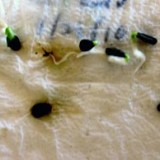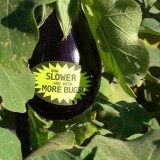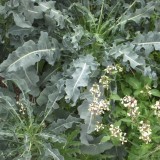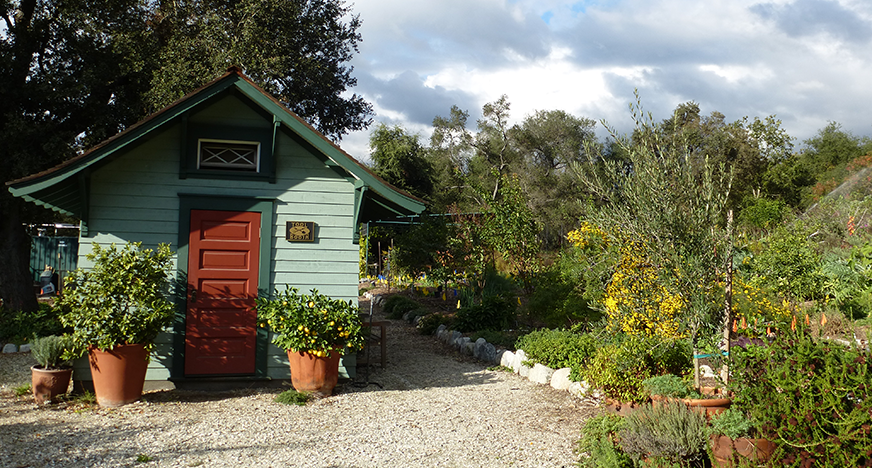
Tasha Via’s straw bale garden.
Michael Tortorello (who profiled us when Making It came out) is one of my favorite writers covering the home ec/gardening subjects we discuss on this blog. He had an article last week in the New York Times, “Grasping at Straw” on straw bale gardening. We’ve very tempted to give the practice a try in our backyard. Why?
- We have lead and zinc contaminated soil so growing veggies in the ground is questionable.
- We live on a hill and it’s easier for us to drag a straw bale up the hill rather than bulk or bagged soil.
- Straw bale gardening is an old and tested practice.
- Straw bale gardening comes with the endorsement of horticulture professor and noted garden myth debunker Linda Chalker-Scott.
- The practice has been tested in dry climates like ours.
- After the bale has decomposed you get compost you can use elsewhere in the yard.
- I suspect that skunks will be less interested in digging in a bale (please correct me if I’m wrong here).
Now, if we had good soil I wouldn’t bother with the extra work of buying and prepping a straw bales garden. But, given the idiosyncrasies of our situation, it seems like a good solution. Frankly, I don’t know why we didn’t think of it sooner. Our thanks go out to Michael for reminding us of this possibility with his article.
The biggest possible downside with this method is that the straw may contaminated with a persistent herbicide, like Dow Chemical’s Clopyralid. This is a type of herbicide that is not broken down by composting. It’s not even broken down in an animal’s digestive track. It can linger in organic matter for a year or two, stunting the growth garden plants. (See Killer Compost).
Despite this risk, we’re going to go ahead and grow some food in bales anyway and see what happens. We’ll also be testing our straw.
So, off we go into another gardening adventure/research pit!
So have any of you tried, or are considering trying, straw bale gardening? How did it work?
Some resources on the topic:
strawbalegardens.com–the website of Joel Karsten, profiled in Tortorello’s article and the author of a book and a downloadable pamphlet on straw bale gardening.
Some tips from an experienced straw bale gardener at The Gardener’s Pantry
We’re going to bioassay (that is, test ) the straw from our local feed store. The Compost Gardener has good instructions for this. In our case, we’re doing the method where you plant beans in soil, and water them with tea made from the straw.
Washington State University–instructions for how to start a Straw Bale garden.





So, maybe my hens have been lucky that I use pinestraw and leaves in their nests and pens. I would hate to be poisoning them and possibly myself as I eat their eggs. I won’t even take grass cuttings or leaves from other yards because I don’t know what other people use on their lawns.
I would bet skunks will dig into the bales.
I’m guessing the straw might be even easier for skunks to get into. Maybe wrapping the bales with chicken wire/hardware cloth/etc. might work?
I want to try this, but am also concerned about herbicides. I have not found a source for organic straw, so maybe the better approach is to ask about use of specific herbicides. Meanwhile, I came upon some information about “No-dig gardening” which basically comprises making a multi layered sheet mulch sandwich as a planting medium. It involves straw, but apparently any dry grassy plant matter will work. It also seems like it would cost less, depending if you already had compost, manure, and topsoil to use, as it is about 3/4 dry grass and/or straw. I’ll let you know how it works.
I live in the lower midwest near St. Louis, and I know that very few herbicides are used on wheat in this area, so there shouldn’t be issues here (I used to work in agriculture). I have no idea about wheat grown under irrigation out in the western states, or spring wheat in the upper midwest. Call the extension office in your area, or email the extension specialists at your land grant institution and ask. every state has a land grant institution, and many heavily ag states will even have a weed extension specialist.
Thank you, I’ll try that!
I live in the eastern SFV and I tried straw bales last year to bad effect. While deep in the bales would stay wet the root balls of all the plants wouldn’t penetrate into the straw. The top soil dried out and the plants were plagued with pests. Right next to it I had a makeshift raised bed that was filled with suburban fill excavated from my front yard. The plants that were the same between the two beds were killed by the heat and pests in the straw bales but thrived in the raised bed. The only thing I can image was that the bales on concrete. I will note use this method again. At least I have six bales with of compost…
I would see if you can find Alfalfa straw. It’s a broad leaf plant and therefore will not be sprayed with 2,4-D , Clopiralid, or Glyphosate. It’s also a legume so I imagine if it grew so should your beans.
alfalfa straw would be called hay and would have more nutritional value than wheat or other straw from harvested grain. however producers do spray alfalfa for weeds, as well as insects. And some of the herbicides labeled for alfalfa would harm beans.
Have there been any studies of nutritional value of produce from strawbale gardens? I wonder if there could be adequate nutrients for successful growth, but a lack of micronutrients found in decent soil. Just a thought. I wonder if liquid seaweed extract or kelp meal would help with this approach.
Yep, that’s something to think about. It feels slightly hydroponic, doesn’t it? The bales are partially composted before use. Some soil is added during planting. I’ve read that supplemental food is important for heavy feeders, so kelp would be a definite possibility.
All in all, if you have good soil, soil is always, always the best place to grow. To my way of thinking, this is a solution for problem areas–they are similar to self-watering containers in that way. Imperfect but a possibility.
I live on a corner with an area by the street I garden. I’d consider this as the soil is still recuperating from the Federal Flood here in N.O.LA. The problem I have is formosan termites. I suppose ya’ll are lucky enough to not have these monsters, but I think they’d view that as home (before moving on to mine) after their Spring swarming blacking out street lights, when tens of thousands of mate. I’m wondering about the fire ants too (we don’t have the crazy raspberry ants. Yet.) You have more placid bugs, I hope?
Yikes!!! Our bugs are indeed more placid here. It’s one of the consolations for the smog. But I really don’t know which critters may or may not like the straw bales.
This is timely. i planted my straw bale garden about a week and a half ago. It was quite successful my first time two years ago. I planned on building a bunch of raised beds this year, but the time to start growing would come and go if I didn’t get veggies growing. I set mine next to a fence with a trellis. I planted cucumbers, beans and tomatoes to attach to the vine. I then planted squash and watermelon so it will fall on the ground. I filled in the rest of the space with peppers, eggplant and strawberries. i planted pretty thick, but I think it will be manageable.
Cool! So, it sounds like it’s been working for you?
I decided to try straw bales because last year the squash bugs were relentless in my garden. No matter what I did the bugs prevailed. My plants are doing fine but 2 of my bales are covered in ants. I sprayed with an ant spray last night so we’ll see what happens.
One other thing – after the Federal Flood my soil was quite toxic – to the point that when I finally attempted to roll up the plants (yes, I was able to literally roll them out of the ground) – six months later my throat began closing up and I made an emergency doctor appointment that hour as I could not breathe. I don’t have allergies. Basil (thai) began popping up all over from previous plants’ seeds and it stank. I’d wait ’til it flowered then yank it up and bag it. After two years, the stink was gone, the normal wonderful scent back. Maybe it’s worth investigating if basil is one of those plants that pulls toxins out of the ground? It definitely has a signal that something is off.
Pingback: Friday Linkage 3/29/2013 | My Green Misadventure
Pingback: You Must Read— Straw Bale Garden: The Breakthrough Method for Growing Vegetables Anywhere, Earlier and with No Weeding. | My Green Misadventure
I don’t have a suggestion for the straw bale gardening. I just have a link to another blog who started her tomatoes on straw bales. In her greenhouse. She has a small farm in NC. http://ruffledfeathersandspilledmilk.com/?p=4426
Enjoy! I always enjoy her writing.
Thank you–she is really funny. And she gives a thumbs down for the bales, too, sadly. From the pics, it looked like her tomatoes were nitrogen-deprived, which would seem to be a risk with the bales.
Pingback: Straw Bale Gardening « Greenhouse Gardening
yes, back in the 70’s Rodale Press ,published a book called “The Ruth Stout No Weed Garden” worked well until Monsoon, then got a little funky. turned it in after harvest and redid new straw on top next year. very little water needed
While doing some MG research about soil amendments, I stumbled across Mrs. Homegrown’s hilarious rant about hay vs. straw. Information with humor is great! Then I found the reference to our myth debunker of WSU and straw bale gardening…a small world indeed.
I need to do an another update on this post–the straw bale garden worked out really well. In fact, we’re having squash from it for dinner tonight. And I’m lucky to be married to someone with a sense of humor!
IS it recommended to use alfalfa hay?
No alfalfa — alfalfa is hay, you must use straw bales.
Straw is a material high in carbon, whereas hay is high in nitrogen. They respond differently to the composting process. And, hay is more expensive.
Pingback: Bad River Gitiganing Community Garden and Other Food Systems Projects, Wisconsin | From Garden Warriors to Good Seeds: Indigenizing the Local Food Movement